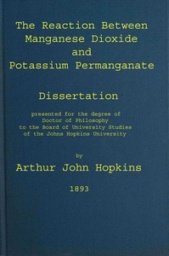

The Reaction Between Mang... (1893)
by Arthur John Hopkins


Summary of Conclusions-⏎ I⏎ Potassium permanganate in weakly acid, in neutral, and in alkaline solutions, is reduced by manganese dioxide which has been prepared in the wet way, with evolution of one and one half atoms of oxygen for each molecule of the permanganate. In other words, the permanganate is reduced to manganese dioxide.⏎ II⏎ This reduction is most rapid in acid and slowest in alkaline solutions.⏎ III⏎ The rate of reduction is greatly increased by increasing the proportion of manganese dioxide.⏎ IV⏎ In concentrated solutions of potassium permanganate, the reduction by manganese dioxide is relatively more rapid than in dilute.⏎ V⏎ Manganese oxide, prepared in the wet way i.e. by the addition of manganese sulphate to a hot solution containing an excess of permanganate, has the composition MnO4 as regards the ratio of manganese to available oxygen.⏎ VI⏎ This oxide is unstable. It loses oxygen spontaneously even at ordinary temperatures.⏎ VII⏎ The oxygen which is thus lost is recovered when the oxide is again treated with an excess of potassium permanganate.⏎ VIII⏎ It is suggested that a partial explanation of the reduction of potassium permanganate by manganese oxide may be found in the instability of the latter; in other words that the reduction may consist in alternate reduction and reoxidation processes. But when the rapidity of the reduction is taken into account, it seems probable that a reaction analogous to that between permanganic acid and hydrogen superoxide must also take place.🏁
Global Leaderboard
| # | Player | Time | Duration | Accuracy | WPM | pp | |
|---|---|---|---|---|---|---|---|
| 1 | |||||||
| 2 | |||||||
| 3 | |||||||
| 4 | |||||||
| 5 | |||||||
| 6 | |||||||
| 7 | |||||||
| 8 | |||||||
| 9 | |||||||
| 10 |


Summary of Conclusions-⏎ I⏎ Potassium permanganate in weakly acid, in neutral, and in alkaline solutions, is reduced by manganese dioxide which has been prepared in the wet way, with evolution of one and one half atoms of oxygen for each molecule of the permanganate. In other words, the permanganate is reduced to manganese dioxide.⏎ II⏎ This reduction is most rapid in acid and slowest in alkaline solutions.⏎ III⏎ The rate of reduction is greatly increased by increasing the proportion of manganese dioxide.⏎ IV⏎ In concentrated solutions of potassium permanganate, the reduction by manganese dioxide is relatively more rapid than in dilute.⏎ V⏎ Manganese oxide, prepared in the wet way i.e. by the addition of manganese sulphate to a hot solution containing an excess of permanganate, has the composition MnO4 as regards the ratio of manganese to available oxygen.⏎ VI⏎ This oxide is unstable. It loses oxygen spontaneously even at ordinary temperatures.⏎ VII⏎ The oxygen which is thus lost is recovered when the oxide is again treated with an excess of potassium permanganate.⏎ VIII⏎ It is suggested that a partial explanation of the reduction of potassium permanganate by manganese oxide may be found in the instability of the latter; in other words that the reduction may consist in alternate reduction and reoxidation processes. But when the rapidity of the reduction is taken into account, it seems probable that a reaction analogous to that between permanganic acid and hydrogen superoxide must also take place.🏁